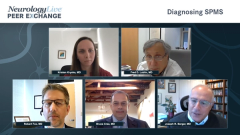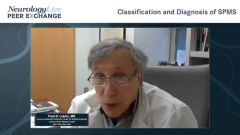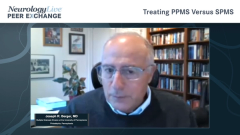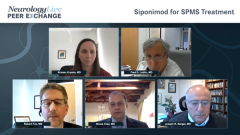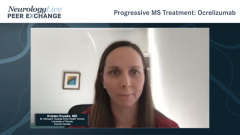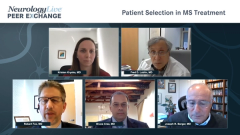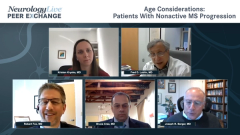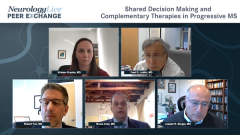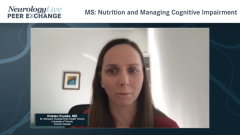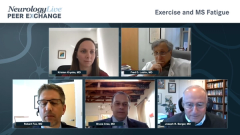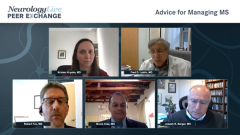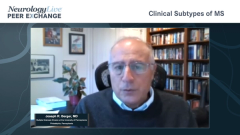
MS Treatment: EXPAND Study Versus ASCEND Study
Experts in the field of multiple sclerosis compare the results of the EXPAND study to the results of the ASCEND study.
Episodes in this series

Bruce Cree, MD: I want you to contextualize this a little bit further for us by comparing the results of the EXPAND study to the results of the ASCEND study.
Robert Fox, MD: We don’t know for sure how siponimod works in progressive MS [multiple sclerosis]. There was a subgroup analysis that was published with the primary paper. I commend the sponsor for conducting this deep-dive subgroup analysis to help understand the types of patients who benefited more vs the ones who may have benefited a little less.
What was clear was that the patients who were more toward the relapsing end of the spectrum seemed to benefit more, meaning the younger patients, patients with lower disability at baseline, patients with a shorter disease duration, and patients with gadolinium-enhancing lesions at baseline. All of those types of patients were more likely to benefit from siponimod than the opposite end of the spectrum: those without gadolinium-enhancing lesions, with an older age at baseline, with a higher disability as measured by EDSS [Expanded Disability Status Scale], and those with a longer disease duration.
It does raise the question of whether, probably not all, but at least a lot of the benefit may have been mediated through the anti-inflammatory effect that we know this class of drug has in relapsing MS. Whether there is additional benefit on the progressive aspects, whatever is driving that in secondary progressive MS, is a little bit less clear at this point.
Compare that to the ASCEND trial, which studied natalizumab in secondary progressive MS. They did not see a slowing of disability in the natalizumab-treated placebo patients, but did see a reduction in the annualized relapse rate and a reduction in new lesions on MRI. It’s a little less clear, but I think the patients in the EXPAND trial had more active inflammation at baseline, were a little bit more to the left side—the relapsing side—of the secondary progressive spectrum, so they may have had a better opportunity to have a beneficial impact from this therapy, which we know has anti-inflammatory activity.
Bruce Cree, MD: That’s possible. Certainly, one possibility is differences in patient populations at baseline. Another could be pharmacological aspects of the drugs that are different. Lymphocyte sequestration and blockade of lymphocyte access to the central nervous system [CNS] share some similarities. Both mechanisms are preventing the lymphocytes from entering the CNS.
Fred D. Lublin, MD: Bruce, there were some technical issues, though, between the 2 studies.
Bruce Cree, MD: Go ahead. Please.
Fred D. Lublin, MD: ASCEND had a tougher job because, if I remember correctly, they had to show sustained disability, meaning that it wasn’t just confirmed at 3 months or 6 months, but sustained through the entire course of the study. I believe that was at the FDA’s request. That is the correct way to do it, because if you’re affecting progression, it should never get better. That’s a tougher metric. I don’t know why they haven’t insisted on that in subsequent studies, because they should, but that makes it harder to do.
Bruce Cree, MD: That’s a great point, Fred. What you’re really talking about when you refer to sustained disability progression, which you defined as confirmed and then sustained to the end of the study, is irreversible disability progression. Right?
Fred D. Lublin, MD: Yes, that’s right.
Bruce Cree, MD: And disability progression that’s not driven by relapses. The EXPAND study did take a look at some of this in a post hoc analysis and try to determine whether there was an effect of the drug in that subgroup of patients who never had relapses. They did a number of statistical models around that and tried to show an effect. The effect was consistent, so there may well be a property of siponimod that is somewhat different from natalizumab in this regard. But in the absence of a head-to-head comparator, and with potential differences in baseline characteristics as well as end points of the study, you make a really good point, that making a cross-trial comparison of this sort is very challenging.
Thank you for watching NeurologyLive® Peer Exchange. If you enjoyed the content, please subscribe to our e-newsletters to receive upcoming Peer Exchanges and other great content right in your inbox.
Transcript Edited for Clarity
Newsletter
Keep your finger on the pulse of neurology—subscribe to NeurologyLive for expert interviews, new data, and breakthrough treatment updates.

